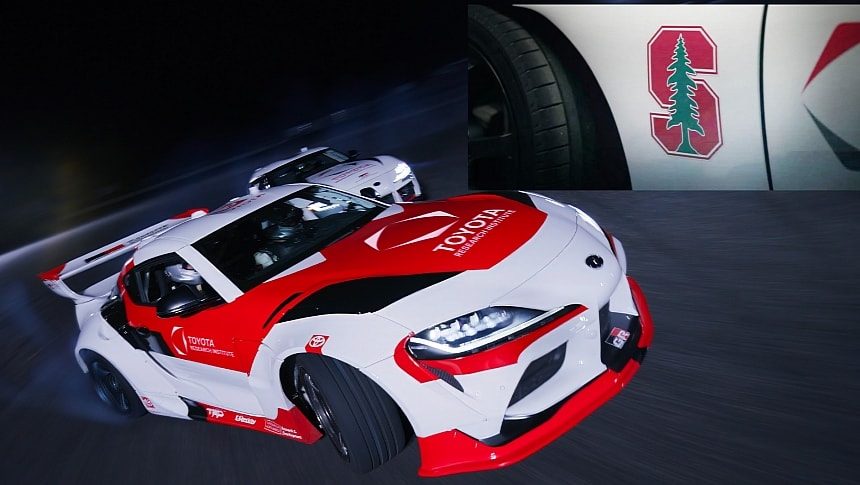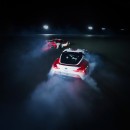Autonomous, self-driving vehicle research is one of, if not the most polarizing and controversial field of study in the entire sector. Many in the public fear this tech, as interactions between AI and human drivers on the road shared by both just sound like a recipe for disaster. However, the engineers at the Toyota Research Institute and their partners at Standford Engineering just put on a display that might boost your faith in autonomous vehicle tech.
If computers and sensors can make a pair of gen-V Toyota GR Supras drift around a racetrack in tandem like a couple of trained professionals, just imagine what future tech could accomplish when applied to a public road set. At least, that's the rationale behind Toyota and Stanford's partnership. Using state-of-the-art AI equipment and software made by Stanford's facilities in California to a track-focused, rear-drive drift machine, scientists fine-tune the AI suite responsible for keeping both cars from crashing mid-drift.
By doing so, this practice of honing the sensitivity and responsiveness of driverless vehicles helps develop software protocols that work just as well on a track as they do in day-to-day traffic, where interaction with human drivers of typical passenger cars becomes a matter of life or death for the occupants of all involved. Through clever technical innovations like a dedicated Wi-Fi network that allows near latency-free interaction between AV-sensitive systems and the vehicle's controls, a level of responsiveness on par with an alert, non-impaired human driver is more within reach than ever.
At the nearby Thunderhill Raceway in Willow, California, that lethal combination of two well, sorted Toyota drift machines with the latest and greatest in AV technology was ready to hit those corners like it's Formula Drift racers behind the wheel. With the ability to adjust throttle and steering geometry parameters up to 50 times per second, there's every chance for these two drift cars to crash into each other along the course. Yet, as you can see, through the miracle of modern computer processing, the autonomous driving suite keeps the pair gliding around corners as if choreographed by a ballet troop.
"Our researchers came together with one goal in mind – how to make driving safer," said Avinash Balachandran, vice president of TRI's Human Interactive Driving division. "Now, utilizing the latest tools in AI, we can drift two cars in tandem autonomously. It is the most complex maneuver in motorsports, and reaching this milestone with autonomy means we can control cars dynamically at the extremes. This has far-reaching implications for building advanced safety systems into future automobiles."
Through these AI drifting sessions, Stanford's suite of some of the world's best AV software is being honed to levels once unimaginable. That means it might show up in dealerships near you far sooner than you might think.
By doing so, this practice of honing the sensitivity and responsiveness of driverless vehicles helps develop software protocols that work just as well on a track as they do in day-to-day traffic, where interaction with human drivers of typical passenger cars becomes a matter of life or death for the occupants of all involved. Through clever technical innovations like a dedicated Wi-Fi network that allows near latency-free interaction between AV-sensitive systems and the vehicle's controls, a level of responsiveness on par with an alert, non-impaired human driver is more within reach than ever.
At the nearby Thunderhill Raceway in Willow, California, that lethal combination of two well, sorted Toyota drift machines with the latest and greatest in AV technology was ready to hit those corners like it's Formula Drift racers behind the wheel. With the ability to adjust throttle and steering geometry parameters up to 50 times per second, there's every chance for these two drift cars to crash into each other along the course. Yet, as you can see, through the miracle of modern computer processing, the autonomous driving suite keeps the pair gliding around corners as if choreographed by a ballet troop.
"Our researchers came together with one goal in mind – how to make driving safer," said Avinash Balachandran, vice president of TRI's Human Interactive Driving division. "Now, utilizing the latest tools in AI, we can drift two cars in tandem autonomously. It is the most complex maneuver in motorsports, and reaching this milestone with autonomy means we can control cars dynamically at the extremes. This has far-reaching implications for building advanced safety systems into future automobiles."
Through these AI drifting sessions, Stanford's suite of some of the world's best AV software is being honed to levels once unimaginable. That means it might show up in dealerships near you far sooner than you might think.















